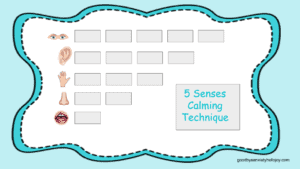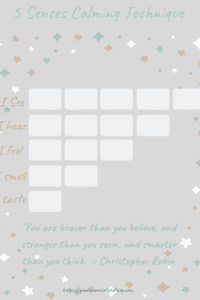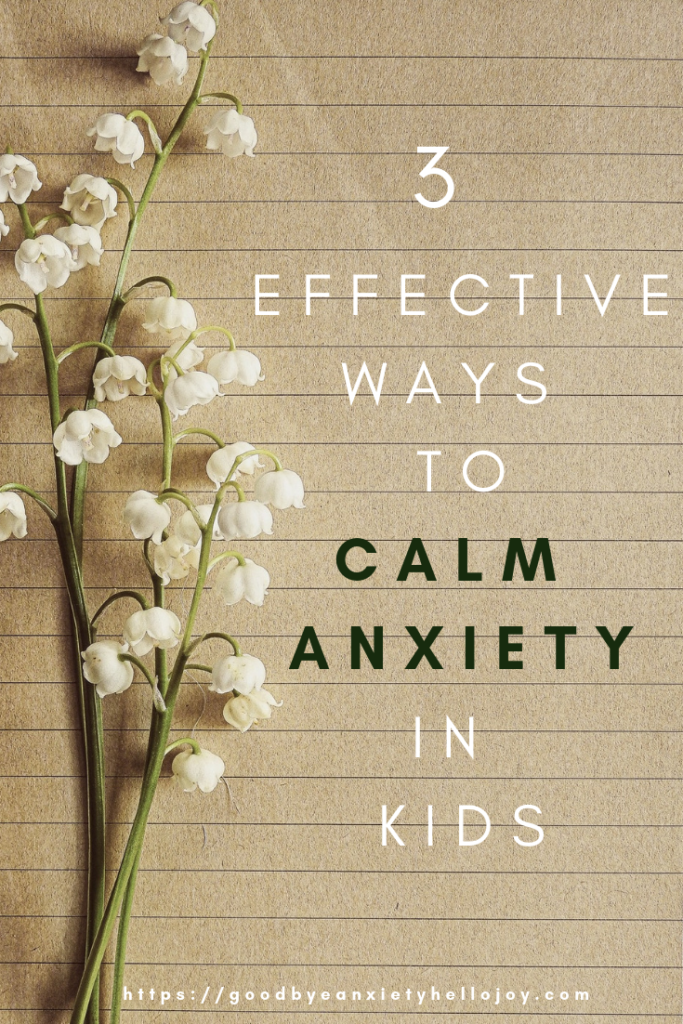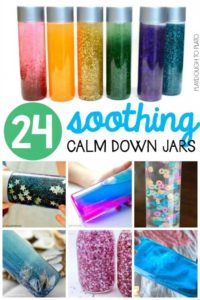3 Effective Ways to Calm Anxiety in Kids
Seeing your child scared, uncomfortable, or sad breaks your heart. You want to make all of the unhappiness go away as quickly as possible. Fortunately, when anxiety is the cause of your child’s distress, there are effective ways to calm anxiety in kids. In order for any type of coping thought or anxiety management skill or tool to be useful, the body and the mind must be calm.
How Do These Ways To Calm Anxiety Work?
Research shows that the breathing center of our brains is directly tied to higher order brain functions. When anxiety is coursing through your body, your brain has entered the “fight or flight” mode, allowing only survival skills to be accessible. There is no rational thinking occurring during this state of mind.
Of course, depending on the level of anxiety at any given time, there will be more or less rational brain function occurring. Keep in mind though, in young children, their level of controlled, rational brain function is already much lower than you as the parent or teacher. That is why calming techniques for kids are so important. The sooner your child learns these techniques, the more effective they will be in calming anxiety.
Deep slow breathes from the stomach immediately send signals to your nervous system to slow it down. Here’s an easy to understand lesson from McKenna Princing at Right as Rain, “Your autonomic nervous system, which controls involuntary actions like heart rate and digestion, is split into two parts. One part, the sympathetic nervous system, controls your fight-or-flight response. The other part, the parasympathetic nervous system, controls your rest and relax response. These two parts of your nervous system can’t be turned on at the same time, which means if you work to activate one, the other will be suppressed.”
Deep, Slow Breathing to Calm Anxiety
This type of breathing takes practice. It is important to practice this throughout the day when your child is not anxious. By doing this, you are setting your child up for more success when he or she needs it during times of anxiety.
The goal is to help your child get to a point where he or she is breathing in through their nose and filling their stomach (not their lungs) with air. Ask your child to pretend that their belly is a balloon and their goal is to fill the balloon up with air. By placing their hand on their stomach, they will see and feel their stomach rising when they are breathing correctly. You can use this technique with children of all ages, teens, and even adults. When my child is upset and anxious, you better believe I am doing this exact same breathing to keep myself from getting anxious (or frustrated).
Kumarah Yoga has a great post with 14 Clever Ways to Breathe With Your Child to Calm Down. I suggest you practice a variety of different breathing techniques with your child to find the ones that are the most useful. My daughter has always liked a breathing exercise similar to “blow out the candles”.
Calm Down Jars Help Kids Relax From Anxiety
Calm down jars provide a visual experience for your child while using the mentioned breathing techniques to reduce anxiety. Even as an adult, there is something incredibly calming when you watch the liquid colors slowly move through the jar. The calming jars are great because they are easy and inexpensive to make. I have used them at home and in my classroom with great success. Check out Playdough to Plato for 24 Calming Jar ideas.
For older children, the free version of The Calm App has a “breathe” option that shows a visual, along with a sound effect, that helps regulate your breathing. This is our family’s most used way to calm anxiety.
As your child is better able to control his or her breathing, they are then able to better focus on coping thought and anxiety management techniques. The freebies library on this site has several free printable PDFs to help with anxiety management. Without calm breathing and rational thought, nothing else can be effective.
Practice Mindfulness
Mindfulness is the idea that you focus on what is happening at the moment. In terms of anxiety, this means thinking about what your body is thinking and feeling at this exact moment. Do you feel your heart racing? If your mind full of worries? By acknowledging these thoughts and feelings you are able to calm down because you recognize them as anxiety, rather than a real threat.
As with breathing, mindfulness is a tool that should be practiced daily when anxiety is not present. This practice allows more successful implementation when needed during moments of anxiety. As a family, we try to practice mindfulness for a few minutes each day. Sometimes this is just sitting on the couch with our eyes closed enjoying the soft, comfortable couch, warm house, and quiet moment. Other times, this means being at the store and acknowledging that we are becoming overly stimulated with all of the noise and people. When this happens, we are able to realize that we can control our thoughts and actions with mindfulness.
Blissful Kids is a great resource for calming activities to practice at home or in school.
Mindfulness With The 5 Senses
As a teacher and a parent, I have found that engaging the five senses has been the most useful mindfulness approach to calming anxiety, even at a very heightened level. The five senes bring thoughts and feelings back into the present. Anxiety is seldom rational, rather it creates a scenario of “what ifs”. Being present in the moment using your 5 senses, returns your mind to the present and replaces the anxiety with reality.

I have created 5 Senses Calming Technique printables that you will have access to as a subscriber in the free child anxiety printable library. This is to be used by children at home or at school. If you have not already done so, subscribe to this site.
 Suggestions for use of these printables: The coping thoughts can be used at home, at school, at a restaurant, or any place that anxiety may be triggered. Coping thoughts are positive thoughts that challenge or replace, the negative anxiety swirling inside your mind. I have provided 6 common, successful thoughts that children can use. Be sure to individualize these thoughts as needed for your child’s anxiety. You could even customize separate ones for school, home, outings, etc.
Suggestions for use of these printables: The coping thoughts can be used at home, at school, at a restaurant, or any place that anxiety may be triggered. Coping thoughts are positive thoughts that challenge or replace, the negative anxiety swirling inside your mind. I have provided 6 common, successful thoughts that children can use. Be sure to individualize these thoughts as needed for your child’s anxiety. You could even customize separate ones for school, home, outings, etc.
The five senses calming technique is also versatile enough to be used in many locations. The idea is to take slow deep breaths while naming 5 things you see, 4 things you hear, 3 things you can feel, 2 things you can smell, and 1 thing you can taste (when applicable). By breathing slowly and focusing on your senses, anxious thoughts are calmed and the rational part of the brain begins to re-engage.
Movement is a Fun Way to Calm Anxiety
When anxiety starts to take hold, begin breathing and return your mind to the present using mindfulness as mentioned above. Equally important, get up and move. Encourage your child to do something active by modeling options for them and participating in the movement. Some children will find these movements silly and that alone can calm the anxiety.
A favorite move for us when my daughter was younger (and I still do it now to embarrass her) is to shake like a dog. Have your child to pretend to be a wet dog shaking all of the water off after a bath. Another great movement activity is to walk like a crab. Most children have learned to do this during gym class at school. The pressure from this movement helps reduces the anxiety in their body.
Some children are not comfortable with these big movements so taking a walk, especially outdoors when possible, allows for a change of scenery and fresh air. It may take a bit of encouragement on your part, but getting up and moving works well, especially combined with controlled breathing and mindfulness, in calming anxiety. For children with anxiety at school, work with the school to create a plan where your child can walk around the hallways when they begin to feel anxious.
Calming Anxiety Empowers Children
You are your child’s biggest support. Make sure they see you using these techniques when you notice yourself getting anxious. Your job is to empower your anxious child, building their confidence to succeed in any situation. Similarly, even if you are not anxious when your child is, do these activities together. Each child is unique and will find the best ways to calm anxiety for themselves. It takes time and practice but these techniques for calming anxiety are effective and easy to use. Share them with teachers, friends, and caregivers so that your child is always supported no matter when the anxiety arises.
Additional resources to help a child or teen calm their anxiety include using stress relief toys, reading children books with relatable characters dealing with anxiety, externalizing anxiety through a worry monster.


I did not have anxiety until I was an adult. And I know how hard it was not only to identify the problem, but to treat it naturally! I count from 100 backwards while breathing deep! You have such great ideas!
Thank you. Counting backward from 100 to calm anxiety is a great idea. My anxiety increased significantly once I had children.
I too believe that children must be taught and encouraged to practise mindfulness at an early age. All three ways you have discussed in this post are great ones to help kids with their mental pressure and anxiety.
Thank you. I wish I had known about mindfulness earlier in order to incorporate it into my life and my children’s life when they were younger.
These are wonderful tips, it is horrible to see our child suffering from anxiety because there´s nothing we can do to make it better, they have to do it themselves but teaching them this simple techniques can be a life saver, especially because they´ll know how to calm themselves down when they get older.
I also use a mix essential oils (lavender, bergamot and Frankincense) and rub it on my daughter´s palms at night when she gets anxious.
It sure helps!
You are right…the helplessness we feel as parents is awful. The great news is that by learning how to help our children, we can teach them to help themselves as they grow! We have also had success with the same essential oils you have mentioned.